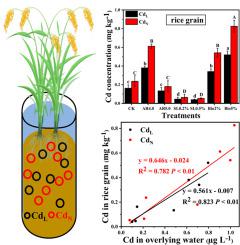Journal of Hazardous Materials ( IF 12.2 ) Pub Date : 2021-05-04 , DOI: 10.1016/j.jhazmat.2021.125998 Qiang Dong 1 , Yanwei Liu 2 , Guangliang Liu 3 , Yingying Guo 2 , Qingqing Yang 4 , Jianbo Shi 5 , Ligang Hu 5 , Yong Liang 4 , Yongguang Yin 6 , Yong Cai 7 , Guibin Jiang 5

|
Phytoavailability of Cadmium (Cd) plays a critical role in its accumulation in soil-rice systems. However, differential aging and phytoavailability of newly introduced Cd (CdN) and legacy Cd (CdL) in the soil-rice system remains unknown. Moreover, distinguishing their aging and phytoavailability is challenging. Enriched 112Cd isotope was introduced into a series of pot experiments, combined with sequential extraction and isotope dilution (110Cd isotopic spike), to investigate the aging and distribution of CdN and CdL under different treatments. The treatments included simulated acid rain, slaked lime, and biochar. CdN aged quickly than CdL in flooded soil and its availability was similar to that of CdL after tillering stage. The grain Cd contents were positively correlated to Cd concentrations in the overlying water. Acid rain reduced the soil pH, increasing the grain Cd, while slaked lime reduced grain Cd content. The acidic biochar used in this study increased grain Cd, possibly through soil acidification-induced Cd release. The differences in bioaccumulation and translocation factors between CdN and CdL in rice plants under slaked lime and biochar treatments suggested their different in vivo complexations and translocations. Analysis of bioaccessibility of CdN and CdL in rice grains provided valuable insights regarding human Cd exposure.
中文翻译:

富集同位素示踪技术在稻田土壤中新引入和遗留镉的衰老,植物有效性以及它们在水稻籽粒中的生物利用度
镉的植物利用率在土壤-水稻系统中的积累中起着至关重要的作用。然而,在土壤-水稻系统中,新引入的Cd(Cd N)和传统Cd(Cd L)的衰老和植物利用率的差异仍然未知。此外,区分它们的衰老和植物利用率具有挑战性。将富集的112 Cd同位素引入一系列盆实验中,结合顺序萃取和同位素稀释(110 Cd同位素峰值),以研究在不同处理条件下Cd N和Cd L的衰老和分布。处理方法包括模拟酸雨,熟石灰和生物炭。Cd N的老化速度快于Cd L分flood期后在淹水土壤中的有效性与Cd L相似。籽粒中Cd含量与上覆水中的Cd含量呈正相关。酸雨降低了土壤的pH值,增加了谷物Cd的含量,而熟石灰降低了谷物Cd的含量。本研究中使用的酸性生物炭可能通过土壤酸化诱导的Cd释放而增加了谷物Cd的含量。熟石灰和生物炭处理下水稻植株中Cd N和Cd L的生物积累和转运因子的差异表明它们在体内的复合和转运不同。Cd N和Cd L的生物可及性分析 谷物中的维生素提供了有关人体镉暴露的有价值的见解。











































 京公网安备 11010802027423号
京公网安备 11010802027423号